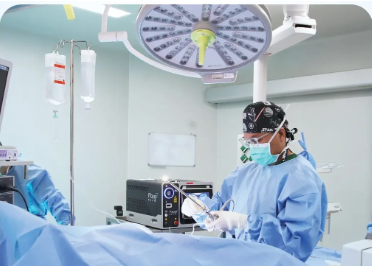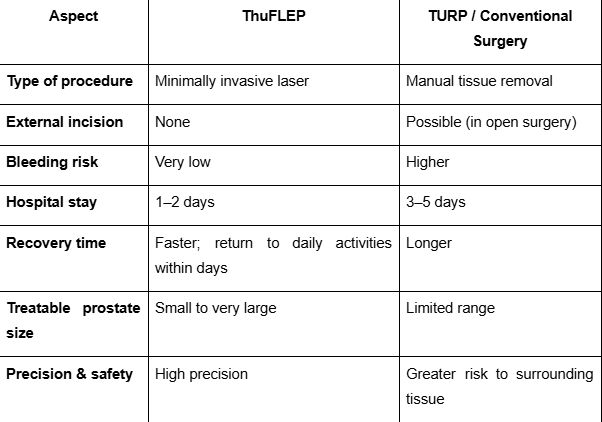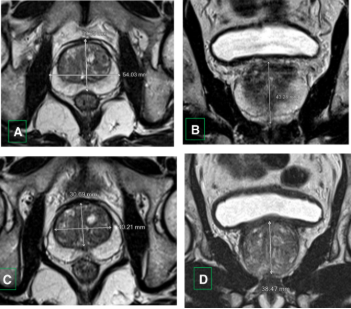By: Geraldus Sigap
What Is Prostate Enlargement (BPH)?
Many men experience difficulty urinating as they age. This condition is often caused by Benign Prostatic Hyperplasia (BPH), a non-cancerous enlargement of the prostate gland located beneath the bladder, which presses against the urethra and obstructs urine flow.
Common symptoms include:
- Weak or interrupted urine flow
- Straining during urination
- Feeling of incomplete emptying
- Frequent urination, especially at night
- Sudden urge to urinate or difficulty holding urine
If left untreated, BPH can lead to urinary tract infections, bladder stones, or even kidney damage.
From Surgery to Laser: A Modern Breakthrough
In the past, patients with severe prostate enlargement often needed open prostate surgery or TURP (Transurethral Resection of the Prostate), which carried a higher risk of bleeding and required a longer recovery period. Today, the Thulium FIber Laser Enucleation of the Prostate (ThuFLEP) procedure offers a minimally invasive laser alternative that is safer, more effective, and has a faster recovery.
What is ThuFLEP?
Thulium Fiber Laser Enucleation of the Prostate (ThuFLEP) is a surgical procedure that uses a high-precision thulium laser to remove enlarged prostate tissue through the urethra, without any external incision. The laser gently “peels away” excess prostate tissue with remarkable accuracy, and the tissue is then extracted using a specialized morcellator device.
The result:
- Restored urine flow
- Significant symptom relief
- Minimal bleeding and faster healing

Advantages of ThuFLEP Compared to Conventional Surgery

How is the ThuFLEP Procedure Performed?
- The patient is given anesthesia (general or spinal).
- A small endoscopic instrument is inserted through the urethra.
- The thulium laser separates the enlarged prostate tissue from its capsule.
- The removed tissue is extracted using a morcellator.
- A catheter is usually placed for 1–2 days to aid recovery.
- The entire procedure typically takes 60–90 minutes, depending on prostate size.
Who Is a Good Candidate for ThuFLEP?
ThuFLEP is ideal for patients who:
- Have moderate to large prostate enlargement
- Experience severe or recurrent urinary symptoms
- Do not respond to medication
- Have a history of urinary retention (inability to urinate)
- Prefer a minimally invasive and safe procedure with fast recovery
The ThuFLEP procedure is ideal for patients with large prostates, even up to approximately 120 ml, without requiring open surgery. The fiber laser technology allows for efficient removal of larger prostate tissue with minimal bleeding and a shorter operative time.

Figure 1. Prostate enlargement shown in MRI
Preoperative Assessments Before ThuFLEP
Before undergoing ThuFLEP surgery, the doctor will perform several important evaluations to assess the prostate condition and ensure the procedure’s safety, including:
- Prostate size assessment, using MRI or TRUS (transrectal ultrasound)
- Uroflowmetry, to measure urine flow strength and rate
- PSA (Prostate-Specific Antigen) test, to screen for prostate cancer
These assessments are essential because ThuFLEP can only be performed if no active prostate cancer is present. Comprehensive preoperative evaluation helps doctors determine whether laser surgery is the safest and most effective option for each patient.
Is ThuFLEP Safe?
Yes. ThuFLEP is now considered a modern gold standard for treating BPH because it:
- Uses high-precision laser energy
- Minimizes bleeding
- Has a lower complication rate
- Preserves erectile function and urinary control
- Is suitable for patients with comorbidities such as heart disease, hypertension, or diabetes
Recovery After ThuFLEP
- Most patients can go home within 1–2 days after the procedure.
- Urinary symptoms improve significantly within a few weeks, with better urine flow and reduced discomfort.
Post-procedure recommendations:
- Drink plenty of water
- Avoid heavy lifting for 1–2 weeks
- Attend follow-up appointments as advised
RS Abdi Waluyo features a dedicated Urology Center equipped with modern facilities and a team of experienced urologists specializing in laser-based procedures such as ThuFLEP. Treatment is handled by experienced urology specialists who manage prostate enlargement and urinary disorders using the latest individualized, evidence-based approaches. If you or your loved ones are experiencing urinary difficulties, frequent nighttime urination, or the sensation of incomplete emptying, don’t delay further evaluation. Consult the Urology Specialist Team at RS Abdi Waluyo, who are ready to assist you with advanced laser treatment and comprehensive care. Call 021-3144989 or make an appointment online via https://abdiwaluyo.com/
Referensi:
- National Cancer Institute. Definition of “transurethral resection of the prostate.” NCI Dictionary of Cancer Terms [Internet]. Bethesda (MD): National Cancer Institute; [cited 2025 Oct 13]. Available from: https://www.cancer.gov/publications/dictionaries/cancer-terms/def/transurethral-resection-of-the-prostate
- Raber, M., Buchholz, N. N. P., Vercesi, A., Hendawi, N. A., Inneo, V., Di Paola, G., Tessa, L., & Hassan, I. M. (2018). Thulium laser enucleation of the prostate (ThuFLEP): Results, complications, and risk factors in 139 consecutive cases. Arab journal of urology, 16(4), 411–416.
- Eldib, D.B., Moussa, A.S. & Sebaey, A. Evaluation of different MRI parameters in benign prostatic hyperplasia-induced bladder outlet obstruction. Egypt J Radiol Nucl Med 50, 22 (2019)

